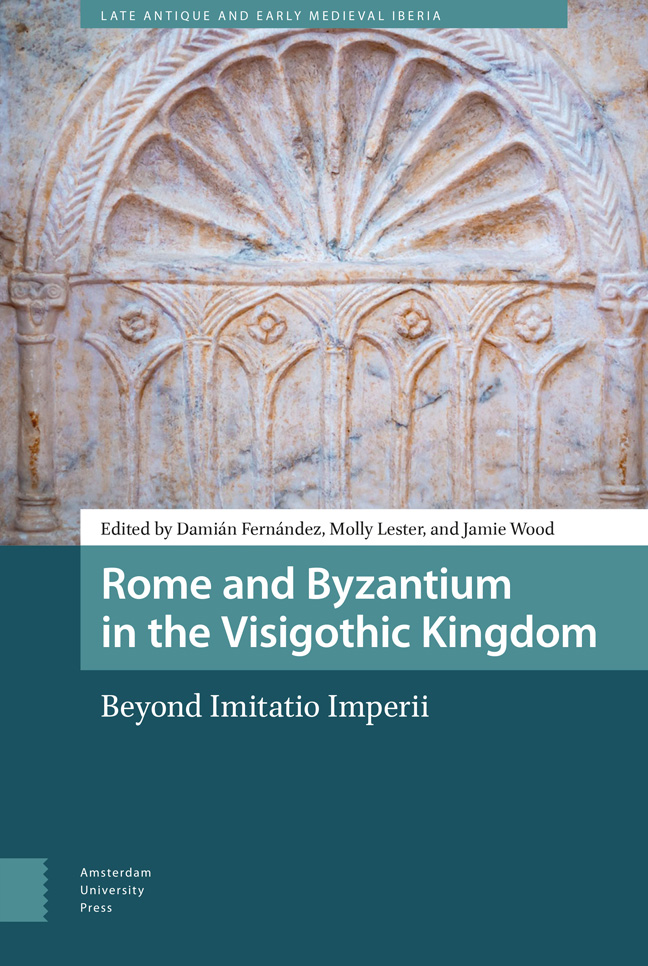Book contents
- Frontmatter
- Contents
- List of Figures and Tables
- Abbreviations
- Acknowledgements
- Maps
- Introduction
- 1 Visigothic Spain and Byzantium: The Story of a Special (Historiographical) Relationship
- 2 The Development of the Visigothic Court in the Hagiography of the Fifth and Sixth Centuries
- 3 Experiments in Visigothic Rulership: Minting and Monetary Reforms under Alaric II
- 4 A Comparison of Roman and Visigothic Approaches to Exile
- 5 The Roman Jewel in the Visigothic Crown: A Reassessment of the Royal Votive Crowns of the Guarrazar Treasure
- 6 Capitalhood in the Visigothic Kingdom
- 7 Making Rite Choices: Roman and Eastern Liturgies in Early Medieval Iberia
- 8 Ethnicity and Imitatio in Isidore of Seville
- 9 Re-imagining Roman Persecution in the Visigothic Passions
- 10 Romanness in Visigothic Hagiography
- 11 Empire and the Politics of Faction: Mérida and Toledo Revisited
- 12 The Agents and Mechanics of Connectivity: The Mediterranean World and the Cities of the Guadiana Valley in the Sixth Century
- 13 Staying Roman after 711?
- Index
8 - Ethnicity and Imitatio in Isidore of Seville
Published online by Cambridge University Press: 20 February 2024
- Frontmatter
- Contents
- List of Figures and Tables
- Abbreviations
- Acknowledgements
- Maps
- Introduction
- 1 Visigothic Spain and Byzantium: The Story of a Special (Historiographical) Relationship
- 2 The Development of the Visigothic Court in the Hagiography of the Fifth and Sixth Centuries
- 3 Experiments in Visigothic Rulership: Minting and Monetary Reforms under Alaric II
- 4 A Comparison of Roman and Visigothic Approaches to Exile
- 5 The Roman Jewel in the Visigothic Crown: A Reassessment of the Royal Votive Crowns of the Guarrazar Treasure
- 6 Capitalhood in the Visigothic Kingdom
- 7 Making Rite Choices: Roman and Eastern Liturgies in Early Medieval Iberia
- 8 Ethnicity and Imitatio in Isidore of Seville
- 9 Re-imagining Roman Persecution in the Visigothic Passions
- 10 Romanness in Visigothic Hagiography
- 11 Empire and the Politics of Faction: Mérida and Toledo Revisited
- 12 The Agents and Mechanics of Connectivity: The Mediterranean World and the Cities of the Guadiana Valley in the Sixth Century
- 13 Staying Roman after 711?
- Index
Summary
Abstract
This paper examines the ways Isidore of Seville appropriated Roman ethnic terms, origin stories, and models of triumphant victory and strategically altered them to better reflect the Hispania he experienced and wanted to build: one ruled by Catholic Goths destined to unite the peoples under their rule in faith. It begins by demonstrating the normalization of gens as a descriptor for a people united politically or religiously, not just by purported kinship. It then shows how he refashioned existing origin stories to give the Goths greater antiquity—and thus legitimacy and status—while neutralizing any negative connotations previous authors had envisioned. It finishes with examples of Isidore's broader tale of the Goths’ progression from barbaric outsiders to worthy insiders destined for Hispania.
Keywords: Isidore of Seville; ethnicity; populus; gens; origins
Analyses of imitatio imperii commonly focus on the ceremonial and symbolic aspects of the Roman empire—victory celebrations, creation of a capital, ceremonial dress and language, imagery on coins, and legal pronouncements— not ethnicity. Perhaps one reason is that in modern English, ‘imitation’ carries derogatory connotations of uninspired copying that remove the agency and creativity of the imitator. Imitated items and practices are seen as poor copies of originals, the latter of which are much more worthy of attention. Under this definition, one would expect an imitator of Rome to claim to be Roman, resembling Athaulf's claim that Goths were unable to submit to law and so should join and revive Rome, not replace Romania with Gothia. Following this logic, the Visigoths may be considered imperfect imitators of Roman ethnic concepts since the identity they claimed was not ‘Roman’ but ‘Gothic’, a poor copy of the original.
However, this is not how the classical rhetorical tradition understood imitatio. Students learned Latin grammar and rhetoric by replicating styles and forms, but this required careful selection of appropriate material to emulate as they wrote on new topics in new ways to rival rather than parrot the original. Aemulatio was such a central part of imitatio that texts regularly paired the terms. Using this definition, Visigothic authors did not just imitate; they borrowed Roman ethnic concepts, adapted their stories of Gothic origins, and asserted their legitimacy within Hispania in order to supersede the empire, not to become it.
- Type
- Chapter
- Information
- Rome and Byzantium in the Visigothic KingdomBeyond Imitatio Imperii, pp. 205 - 222Publisher: Amsterdam University PressPrint publication year: 2023



